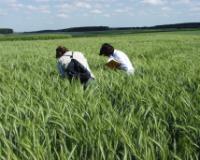ENV IPMHUB › Training/knowledge exchange programmes
Training/knowledge exchange programmes
 |
IPM is complex and requires training and knowledge exchange to enable farmers to adopt IPM methods and new technologies. Participatory training approaches can significantly contribute to the uptake of innovative solutions by growers. |
| © JKI/SDS |
Australia • Belgium • Canada • Denmark • Germany • Estonia • Ireland • Japan • Netherlands • New Zealand • Portugal • Slovenia • Spain • United Kingdom • United States • FAO
Belgium |
Flemish Region: IPM is an essential and obligatory item for advisors, distributors and users of professional productsin the permanent training of the professional users of PPP.
FAO |
The FAO IPM programme currently comprises three regional programmes (Asia, Near East and West Africa) and several stand-alone national projects. Under these programmes and projects, FAO provides assistance in capacity building and policy reform, and facilitates collaboration among ongoing National IPM Programmes:
Examples of available techniques in the IPM toolbox that are part of training programmes
There is a wide variety of techniques that can be applied under IPM approaches. Applicability of individual techniques depends on various factors, including: the crop, the cropping system, the pest complex, the climate, the agro-ecological conditions, etc. Generally, IPM involves a combination of techniques. Some examples of such techniques are:
- Population monitoring
- Trapping (pheromone trapping, sticky traps, water traps, etc.)
- Counts of eggs, larva/nymphal instars, pupae, adults (sweep nets) etc.
- Cultural practices that can help prevent buildup of pests or decrease their pest status
- Use of pest-resistant or highly competitive crop varieties
- Field sanitation, use of quality seeds and seed bed sanitation
- Crop rotation
- Inter-cropping
- Managing sowing, planting or harvesting dates
- Water/irrigation management
- Soil and nutrient management (including mulching, zero/low tillage, fertilizer management)
- Practices to enhance the buildup of naturally existing populations of natural enemies (See Fig 2 below)
- Hand-picking of pests or hand-weeding
- Use of traps or trap crops
- Mechanical/physical controls (including barriers, crushing devices and use of heat)
- Post-harvest loss prevention
- Biological inputs that can help manage pest populations
- Biological control (biocontrol) through release of predators, parasites or pathogens
- Biological control through fish, ducks, geese, goats, etc.
- Release of sterile male insects (sterile insect technology; SIT)
- Bio-Pesticides
- Biological preparations (e.g. natural plant extracts, e.g. Neem, Azadirachta indica)
- Chemical inputs
- Chemicals that disrupt insect behavior (e.g.: pheromones)
- Induced resistance activating compounds
- Growth-regulators
- Conventional pesticides
Related Documents

